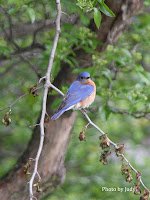Eastern Bluebird
(Sialia sialis)
 My husband and I were at Owen Park. Out for a stroll. It's one of my favorite places to go birding. This beauty was sitting on a bluebird nesting box not far from us. As you may know, the eastern bluebird nests in the same nesting box each year. Want to see the bluebirds? When you go for a walk, keep your eyes on the nesting box. Most times, I have seen the female on the nesting box with the male on a nearby bush. Of course, it's much easier to see them before the foliage blooms.
My husband and I were at Owen Park. Out for a stroll. It's one of my favorite places to go birding. This beauty was sitting on a bluebird nesting box not far from us. As you may know, the eastern bluebird nests in the same nesting box each year. Want to see the bluebirds? When you go for a walk, keep your eyes on the nesting box. Most times, I have seen the female on the nesting box with the male on a nearby bush. Of course, it's much easier to see them before the foliage blooms.
I love the eastern bluebird but didn't know that they were a member of the thrush family until I did my research for this posting. There are two other bluebirds: the western and the mountain. Those of us here in Wisconsin only see the eastern bluebird. They are only found in the U.S. and Canada. The photo to the left was taken at Stricker Pond in the month of May. They live approximately 10 years. Remember that loss of land to buildings does cause a shortage of bluebirds.
Have you ever watched a bluebird feed? It likes to hover to look for and grab food. The bluebirds eat a variety of foods: insects (including grasshoppers, caterpillars, spiders, and beetles) as well as a pretty big amount of berries (including blueberries, dogwood berries, honeysuckle, currants, and more). As you can see on the photo to the left, the bluebird is sitting on a tree that has berries on it. Now that we know that they eat berries, I'm pretty sure that this bird ate some of the berries that day.
 The female bluebird on the nesting box to the right was taken at the local arboretum. This bird has also returned to the same nesting box. So, whenever you see a bluebird, take note where you see them and then check out the same area the following year.
The female bluebird on the nesting box to the right was taken at the local arboretum. This bird has also returned to the same nesting box. So, whenever you see a bluebird, take note where you see them and then check out the same area the following year. How did the bluebird get its name? Their name comes from the Greek word "sialis." What does sialis mean? It means that they are a kind of bird. The eastern bluebird has been here more than 11,000 years.
 Whenever I go to a park that has trails alongside tall grasses, I watch out for the bluebirds. The bluebird on the ground was taken at the local arboretum. This was the first time I had seen one on the ground. It was fun looking at each other.
Whenever I go to a park that has trails alongside tall grasses, I watch out for the bluebirds. The bluebird on the ground was taken at the local arboretum. This was the first time I had seen one on the ground. It was fun looking at each other.Did you have fun learning about the eastern bluebird? I hope so.
Coming next week: learn about the tulip.
Thank you for visiting!
Judy
References:
Elphick, C., Dunning, J.B. Jr.,
& Sibley, D.A. (2001). National Audubon Society: The Sibley Guide to Bird
Life & Behavior.
Kaufman, K. (1996). Lives of North
American Birds.
Wells,
D. (2002). 100 Birds and How They Got Their Names.



No comments:
Post a Comment